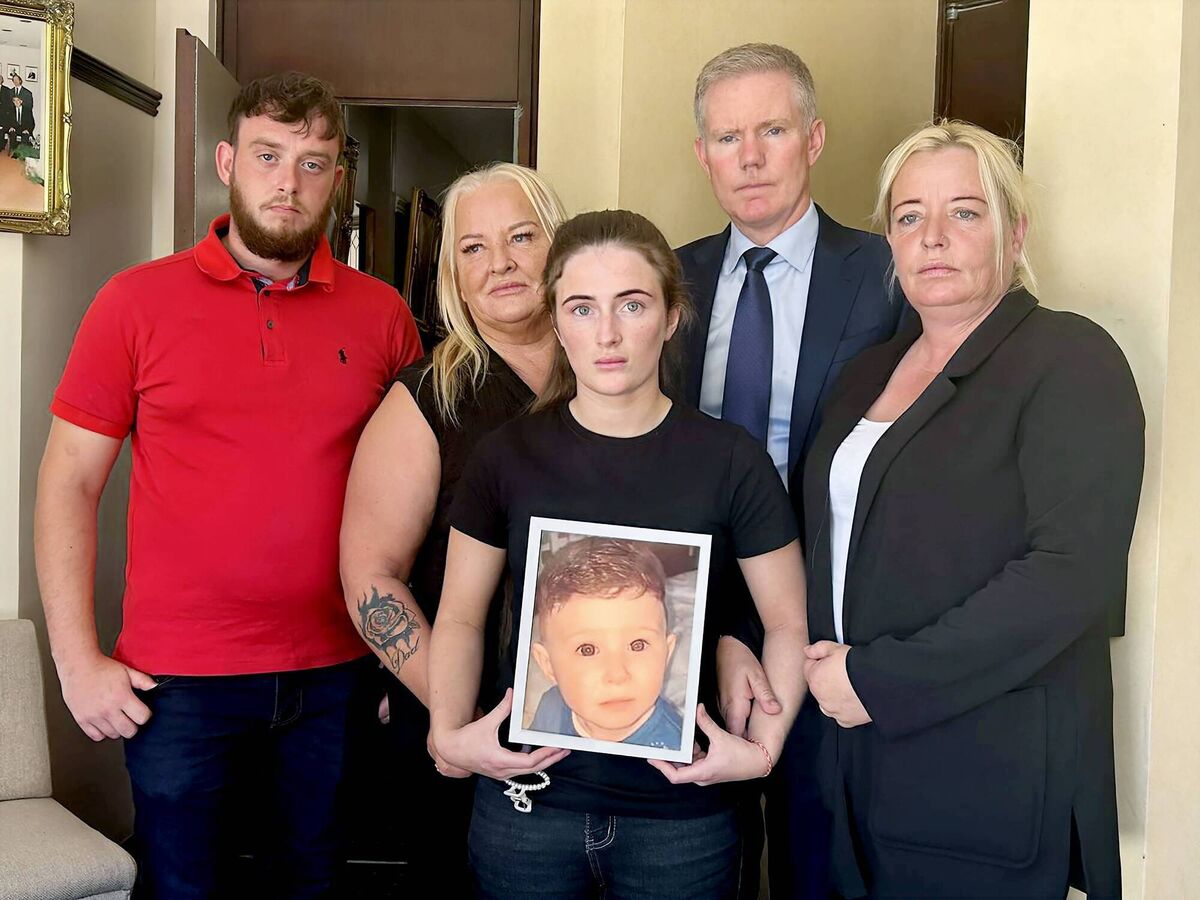Toddler’s fentanyl death ‘was an accident waiting to happen’

Christopher McDonagh's mother Leanne Marshall with Jack Clarke. Picture: Liz Dunphy
A toddler whose "hearty laugh lit up the whole place with joy" died of fentanyl poisoning after accidentally ingesting or absorbing the drug through his terminally ill uncle’s transdermal patch.
Neither HSE carers nor the patient or the child’s family had been warned that the patch contained fentanyl in what was described as a "massive system failure".
Christopher McDonagh Marshall was just 20 months old when he was found limp and unresponsive at his home in Roscrea, Co Tipperary, on November 20, 2023.
Just 15 minutes earlier, he had been “perfect” and laughing while watching his favourite cartoon, .
An autopsy found levels of fentanyl in his system that were 10 times the adult therapeutic level and would be lethal to an adult.
The child’s death was preventable, Laois Coroner’s Court heard, had the family and caregivers been warned about the drug and its potentially lethal potency.
The lack of warnings given about the medication revealed a "massive system failure" which could result in future tragedies if not addressed, barrister for the family John Sweetman warned.
The coroner, Eugene O’Connor, will now devise specific recommendations on how such tragedies can be averted in future.
Christopher’s heartbroken family has appealed for learnings his death so that no other family has to suffer their pain.
“I just hope this doesn’t happen to any other family,” his grandmother, Kelly Marshall, told Portlaoise Coroner’s Court.
The family had suffered family bereavements before Christopher’s birth in March 2020 but the child’s hearty laugh “lit the whole place up with joy", his grandmother said.
“After years of sadness, he brought light and life into the house.”
Christopher was always putting things in his mouth, “as kids would”, she said.
Described as ‘the funniest little boy” and “mischievous”, his family called him ‘Elf on the Shelf’ in the weeks before his death on November, 20, 2023, as they prepared for Christmas, decorating the house and buying him presents.

His uncle Joe Marshall was suffering lung failure and had stage four cancer and was on palliative care in the family home.
He was a father figure to Christopher and called him “my small little bird”.
He would get up to give the child breakfast and bottles and even when suffering extreme physical pain would make sure he played with the little boy.
The pair were extremely close and Christopher would often cuddle up in Joe’s arms and lie on his chest as they watched cartoons together and played.
But Joe had also started wearing fentanyl patches on his chest, arms and back — "wherever they would stick", the coroner’s court heard.
Because Joe was ill, he would perspire and the patches could come off, the court heard.
Christopher’s mother Leanne Marshall said that her “world fell apart” when her son died.
He was born two weeks early on March 22, 2022, and was a small but healthy child.
“When I looked at Christopher, he taught me the true meaning of love, something I never felt before,” Leanne said.
“Christopher was a happy baby.
“He was mischievous […] the funniest little boy. All he did was laugh and laugh.
"Joe was like a father figure to Christopher.
“I was one proud sister to have a brother like him.
“Chris would often fall asleep on Joe.
“Joe would often put him on his chest or in his arms.”
Leanne, described in court as a “brilliant” mother, had popped out to a neighbour’s house to collect a present she had ordered for her son for Christmas.
Although only out briefly, she rang home to check on her toddler and was told he was "perfect" and was watching and laughing.
Her brother Joe sent her a snap of her son "asleep on the floor" but then phoned her and asked her to come home.
“I could hear everyone screaming in the background,” Leanne said.
Leanne ran home to find her son unconscious and being given CPR.
He was later pronounced dead in hospital.
Paul Carey, a HSE worker specialising in palliative care, was caring for Joe.
He collected Joe’s medication from the pharmacy but Joe was responsible for his own medication, he said.
Milford Hospice started him on a fentanyl patch for pain management when a morphine pump had to be removed for fear of sepsis after Joe developed cellulitis, the coroner’s court heard.
“Milford said the patch had to be changed every three days. There was no other medical information given,” Mr Carey said.
The patch would be placed on his chest, arm, or back, but would often fall off.
Family members would reapply when Mr Carey was not there, he said.
He would find tape over the patch where family members had reapplied it, he said in a deposition read to the court.
When throwing out the patch, Mr Carey would wrap it in a used glove and place it in a bin with a lid over it in the kitchen or outside.
He was “shocked” after the autopsy revealed the child had been exposed to fentanyl.
He then learned that Joe’s patch had contained fentanyl. But he said he never knew this before.
“There should be way more awareness around the patch,” Mr Carey said.
Colette McEvoy, a HSE healthcare assistant who worked with Mr Carey tending to Joe, said that the fentanyl patch looked like a nicotine patch.
It was given in a clear plastic bag, with no information, no box and no instructions, she said.
The patch, to be changed every three days, would already be peeling off after one day and would have to be taped back in place, the court heard.
Joe was so ill he perspired which compromised the patch’s adhesive qualities.
Ms McEvoy was “distraught” when she found that morphine was found in little Christopher at autopsy.
“I thought it was like a nicotine patch,” Ms McEvoy said.
Dr John O’Neil carried out an autopsy on Christopher’s body on November, 22, 2023 in Crumlin.
The child was normal with no evidence of major infections.
His cause of death was fentanyl toxicity, with the synthetic opioid present at 10 times the therapeutic level for adults.
This level would cause toxicity and death in both adults and children, he said.
The drug, a powerful painkiller, can be prescribed for palliative cancer care and pain. It can often come in a patch or a lollipop, he said.
The high level of the drug detected would have caused a painless and extremely quick death, he said.
He would have fallen unconscious and stopped breathing because opioids suppress respiratory receptors in the brain, Dr O’Neil said.
Mr Sweetman noted that Joe Marshall had a prescription for a 100mcg per hr transdermal fentanyl patch at the time of the child’s death.
“His uncle would nurse him, he would lie on his chest, the patches would be there,” Mr Sweetman said.
It would appear that the fentanyl transferred from the patient’s patch to the child, Mr Sweetman said.
Dr O’Neil said that while the child died of fentanyl toxicity, the route by which he was exposed to that “was not clear”.
It was not clear whether the child consumed a patch or absorbed it some other way, he said.
Naloxone, a drug that can reverse opioids, is recommended for patients prescribed fentanyl and for their caregivers, Mr Sweetman said.
Naloxone can be given as a nasal spray and can be administered to children in the case of opioid exposure, Mr Sweetman noted.
The case was “a tragedy of extreme circumstances,” he said.
The only way the child could have been exposed to fentanyl was through his uncle’s patch, he said.
“It could so easily have been avoided,” he said.
Had any warning been given to the parties involved “this would not have happened,” he said.
In the US, there are warnings on these patches, he said.
Children can overdose on both new and used fentanyl patches, Mr Sweetman said.
And the FDA has recommended having naloxone as a nasal spray to reverse any accidental opioid exposure, he said.
Every fentanyl patch prescribed should come with warnings to keep it out of the reach of children, he said.
And there should be warnings that it could be transferred from adult to child, he said.
“No one was aware of the seriousness of this medication,” he said.
“This was an accident waiting to happen and has the capacity to happen again and again and again.”
Laois coroner, Mr Eugene O’Connor, gave a narrative verdict on the child’s death.
“We don’t know exactly how Christopher got the fentanyl, the patch could have fallen on the floor,” he said.
But he promised to make clear recommendations for authorities on the prescribing, dispensing and supervising of such drugs which he would send first to the case lawyers for input from the family before sending to the relative authorities.












